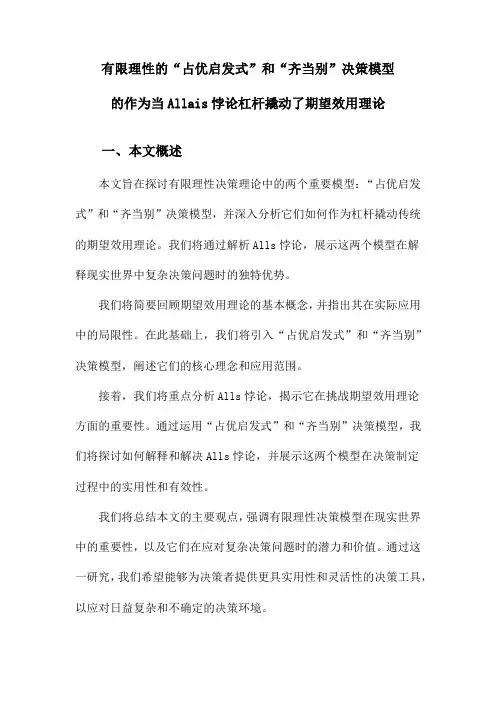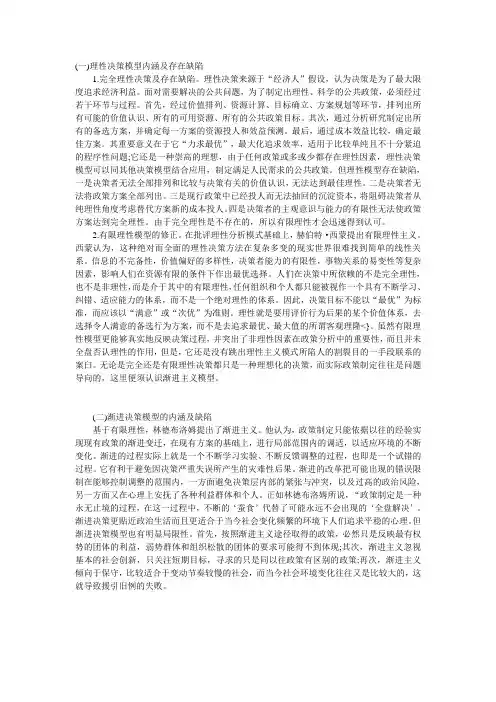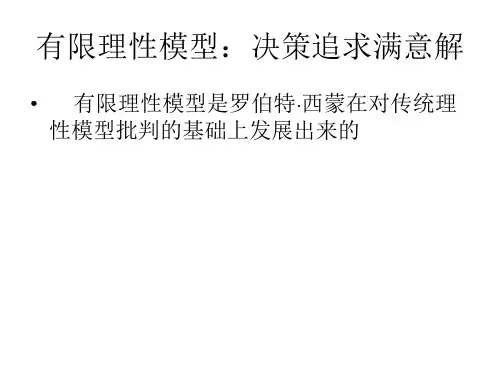有限理性模型解读
- 格式:pdf
- 大小:82.72 KB
- 文档页数:46


有限理性的“占优启发式”和“齐当别”决策模型的作为当Allais悖论杠杆撬动了期望效用理论一、本文概述本文旨在探讨有限理性决策理论中的两个重要模型:“占优启发式”和“齐当别”决策模型,并深入分析它们如何作为杠杆撬动传统的期望效用理论。
我们将通过解析Alls悖论,展示这两个模型在解释现实世界中复杂决策问题时的独特优势。
我们将简要回顾期望效用理论的基本概念,并指出其在实际应用中的局限性。
在此基础上,我们将引入“占优启发式”和“齐当别”决策模型,阐述它们的核心理念和应用范围。
接着,我们将重点分析Alls悖论,揭示它在挑战期望效用理论方面的重要性。
通过运用“占优启发式”和“齐当别”决策模型,我们将探讨如何解释和解决Alls悖论,并展示这两个模型在决策制定过程中的实用性和有效性。
我们将总结本文的主要观点,强调有限理性决策模型在现实世界中的重要性,以及它们在应对复杂决策问题时的潜力和价值。
通过这一研究,我们希望能够为决策者提供更具实用性和灵活性的决策工具,以应对日益复杂和不确定的决策环境。
二、期望效用理论与Allais悖论期望效用理论(Expected Utility Theory, EUT)是经济学和决策科学中一种基础的决策分析工具。
它假设决策者是理性的,即他们会根据概率和潜在的收益或损失来做出最优决策。
在EUT的框架下,一个决策问题可以表示为不同可能结果的概率分布和相应的效用值。
决策者的目标是最大化期望效用,即每个可能结果的效用与其发生概率的乘积之和。
然而,尽管EUT在理论上具有吸引力,但它在实际应用中却遭遇了一些挑战。
其中最著名的挑战之一便是Allais悖论。
Allais悖论由法国经济学家Maurice Allais在1953年提出,它揭示了EUT在某些情况下可能无法准确预测或解释个体的决策行为。
Alls设计了一个著名的实验,其中包含了两个选择情境。
在第一个情境中,决策者需要在确定获得一个小额奖金和有一定概率获得一个较大奖金但同样概率获得零之间做出选择。

有限理性模型西蒙的有限理性模型(Simmon's Bounded Rationality Model)什么是有限理性模型?20世纪50年代之后,人们认识到建立在“经济人”假说之上的完全理性决策理论只是一种理想模式,不可能指导实际中的决策。
赫伯特·西蒙(Herbent Simon)提出了满意标准和有限理性标准,用“社会人”取代“经济人”,大大拓展了决策理论的研究领域,产生了新的理论——有限理性决策理论。
有限理性模型又称西蒙模型或西蒙最满意模型。
这是一个比较现实的模型,它认为人的理性是处于完全理性和完全非理性之间的一种有限理性。
有限理性模型的主要观点有限理性模型的主要观点如下:(1)手段-目标链的涵有一定矛盾,简单的手段-目标链分析会导致不准确的结论。
西蒙认为,手段-目标链的次序系统很少是一个系统的、全面联系的链,组织活动和基本目的之间的联系常常是模糊不清的,这些基本目的也是个不完全系统,这些基本目的部和达到这些目的所选择的各种手段部,也存在着冲突和矛盾。
(2)决策者追求理性,但又不是最大限度地追求理性,他只要求有限理性。
这是因为人的知识有限,决策者既不可能掌握全部信息,也无法认识决策的详尽规律。
比如说,人的计算能力有限,即使藉助计算机,也没有办法处理数量巨大的变量方程组;人的想象力和设计能力有限,不可能把所有备择方案全部列出;人的价值取向并非一成不变,目的时常改变;人的目的往往是多元的,而且互相抵触,没有统一的标准。
因此,作为决策者的个体,其有限理性限制他作出完全理性的决策,他只能尽力追求在他的能力围的有限理性。
(3)决策者在决策中追求“满意”标准,而非最优标准。
在决策过程中,决策者定下一个最基本的要求,然后考察现有的备择方案。
如果有一个备择方案能较好地满足定下的最基本的要求,决策者就实现了满意标准,他就不愿意再去研究或寻找更好的备择方案了。
这是因为一方面,人们往往不愿发挥继续研究的积极性,仅满足于已有的备择方案;另一方面,由于种种条件的约束,决策者本身也缺乏这方面的能力。



(一)理性决策模型内涵及存在缺陷1.完全理性决策及存在缺陷。
理性决策来源于“经济人”假设,认为决策是为了最大限度追求经济利益。
面对需要解决的公共问题,为了制定出理性、科学的公共政策,必须经过若干环节与过程。
首先,经过价值排列、资源计算、目标确立、方案规划等环节,排列出所有可能的价值认识、所有的可用资源、所有的公共政策目标。
其次,通过分析研究制定出所有的备选方案,并确定每一方案的资源投人和效益预测。
最后,通过成本效益比较,确定最佳方案。
其重要意义在于它“力求最优”,最大化追求效率,适用于比较单纯且不十分紧迫的程序性问题;它还是一种崇高的理想,由于任何政策或多或少都存在理性因素,理性决策模型可以同其他决策模型结合应用,制定满足人民需求的公共政策。
但理性模型存在缺陷,一是决策者无法全部排列和比较与决策有关的价值认识,无法达到最佳理性。
二是决策者无法将政策方案全部列出。
三是现行政策中已经投人而无法抽回的沉淀资本,将阻碍决策者从纯理性角度考虑替代方案新的成本投人。
四是决策者的主观意识与能力的有限性无法使政策方案达到完全理性。
由于完全理性是不存在的,所以有限理性才会迅速得到认可。
2.有限理性模型的修正。
在批评理性分析模式基础上,赫伯特·西蒙提出有限理性主义。
西蒙认为,这种绝对而全面的理性决策方法在复杂多变的现实世界很难找到简单的线性关系。
信息的不完备性,价值偏好的多样性,决策者能力的有限性,事物关系的易变性等复杂因素,影响人们在资源有限的条件下作出最优选择。
人们在决策中所依赖的不是完全理性,也不是非理性,而是介于其中的有限理性,任何组织和个人都只能被视作一个具有不断学习、纠错、适应能力的体系,而不是一个绝对理性的体系。
因此,决策目标不能以“最优”为标准,而应该以“满意”或“次优”为准则。
理性就是要用评价行为后果的某个价值体系,去选择令人满意的备选行为方案,而不是去追求最优、最大值的所谓客观理隆<}。


有限理性Bertrand模型的动力学分析摘要:研究了具非线性成本的有限理性Bertrand模型的动力学,分析了此非线性系统均衡的存在与稳定性问题,观察到了分叉、混沌行为等复杂现象,并对混沌现象的影响及控制做了有益的探讨。
关键词:有限理性;Nash均衡;动态演化;稳定性中图分类号: F713 文献标识码: ADynamics of Bertrand model with bounded rationalityZeng xiang-jin, Yi qi-guo(School of Sciences ,Wuhan University of Technology, Wuhan ,Hubei ,China,430070)Abstract : A Bertrand model with bounded rationality are studied. We analyze the existence and stability of the nonlinear system, and observe the complicated phenomenon such as bifurcation and chaos. We also study the influence and control of chaos and gain some helpful results.Key words : bounded rationality ; Nash equilibrium; dynamical evolution; stabilityZeng Xiang-jin :Prof . ; School of Sciences , WU T , Wuhan 430070 , China.1 引言近年来,关于有限理性条件下的寡头博弈的研究工作引起了越来越多的经济学者的兴趣。
Bischi和Naimzada 研究了一个具线性成本的有限理性双寡头博弈模型,Ahmed , Agiza 以及Hassan等把Puu 的模型修改成具非线性成本的有限理性多寡头博弈模型和不同行为规则的寡头非线性博弈的混沌动力学,观察到了分叉、混沌行为等复杂现象。



第二节几种重要的政策分析模型——理解公共政策的有效途径一、传统理性模型:决策追求最优解什么是理性?它的英文是Rationality,中文通常解释为合理、有理,它与感性相对,指人从理智上控制行为的能力。
买汽车光挑颜色,买衣服只注意款式,作决定选择抽签,做事情喜欢打赌,这都不能说是理性的行为。
在“廊桥遗梦”这部电影中,女主角佛郎西斯卡望着情人的汽车在雨中拐弯消失,几经犹豫而最终没有走下丈夫的汽车,她的行为是理性的选择。
当然,在评价某种行为是理性的或非理性的时候,人的价值判断起很大的作用。
某种行为可能你认为是理性的,但别人却认为是非理性的。
我们在谈到理性概念的时候,往往是以共识性标准为前提的。
理性模型起源于传统经济学的理论,传统经济学理论是以“经济人”的假设为前提的。
那么什么是“经济人”呢?一般来讲,“经济人”自私且功利,做任何事都以满足个人最大利益需要为目标。
分析经济人的行为实际上很简单,他之所以这样做而没有那样做,就是因为这样做可以最大限度地满足他的利益需要。
这种带有强烈自利特征的经济理性尽管十分不可爱,但却非常有用。
因为我们惊奇地发现,社会财富这块蛋糕在市场理性的博弈中越做越大。
市场机制这只看不见的手,会使人的自利行为导致利他的结果。
以“经济人”假设为前提的理性优化模型,为微观经济学的发展提供了便利的条件,同时也对当时经济领域的微观决策起到了一定的指导作用。
它舍弃了一些次要变量,使问题的分析得以简化,形成有效的分析框架,能够被用来解释资本主义市场活动中的诸多现象。
因此,其影响迅速蔓延到社会生活的其它领域,当时这种假设几乎被认为是一个不证自明的公理,是解释人类行为不可缺少的依据。
的确,理性行为的概念是一个非常有力的解释原则,因为它有着许多人类行为的经验依据。
我们经常对其它人这样解释我们的行为,“我想达到X这样一种目的,所以我选择了Y 这样一种方式。
”同样,这也是我们理解其它人行为的基本思路。
基于这种考虑,我们一样可以用这种模式去解释一个政府的行为。
有限理性模型西蒙的有限理性模型(Simmon's Bounded Rationality Model)什么是有限理性模型20世纪50年代之后,人们认识到建立在“经济人”假说之上的完全理性决策理论只是一种理想模式,不可能指导实际中的决策。
赫伯特·西蒙(Herbent Simon)提出了满意标准和有限理性标准,用“社会人”取代“经济人”,大大拓展了决策理论的研究领域,产生了新的理论——有限理性决策理论。
有限理性模型又称西蒙模型或西蒙最满意模型。
这是一个比较现实的模型,它认为人的理性是处于完全理性和完全非理性之间的一种有限理性。
有限理性模型的主要观点有限理性模型的主要观点如下:(1)手段-目标链的内涵有一定矛盾,简单的手段-目标链分析会导致不准确的结论。
西蒙认为,手段-目标链的次序系统很少是一个系统的、全面联系的链,组织活动和基本目的之间的联系常常是模糊不清的,这些基本目的也是个不完全系统,这些基本目的内部和达到这些目的所选择的各种手段内部,也存在着冲突和矛盾。
(2)决策者追求理性,但又不是最大限度地追求理性,他只要求有限理性。
这是因为人的知识有限,决策者既不可能掌握全部信息,也无法认识决策的详尽规律。
比如说,人的计算能力有限,即使藉助计算机,也没有办法处理数量巨大的变量方程组;人的想象力和设计能力有限,不可能把所有备择方案全部列出;人的价值取向并非一成不变,目的时常改变;人的目的往往是多元的,而且互相抵触,没有统一的标准。
因此,作为决策者的个体,其有限理性限制他作出完全理性的决策,他只能尽力追求在他的能力范围内的有限理性。
(3)决策者在决策中追求“满意”标准,而非最优标准。
在决策过程中,决策者定下一个最基本的要求,然后考察现有的备择方案。
如果有一个备择方案能较好地满足定下的最基本的要求,决策者就实现了满意标准,他就不愿意再去研究或寻找更好的备择方案了。
这是因为一方面,人们往往不愿发挥继续研究的积极性,仅满足于已有的备择方案;另一方面,由于种种条件的约束,决策者本身也缺乏这方面的能力。
2006.1【哲学百家】摘要:理性模式是以追求“最佳”作为其基本特色的,它的决策模式的哲学思想本源于传统的“经济人”理论,认为决策者在作出决策时是具有完全理性的。
然而在20世纪40年代,以H·A·西蒙为首的一些行政学家和组织学家对这一理想色彩较浓的理性决策模式进行了批判,认为事实上完全的“经济人”是不存在的,理性决策模式所要求的人类的那种理性在现实中也同样不存在。
决策者在作出决策时往往受到信息、时间、技术等外部因素及其自身的认知、人格、态度等内部因素的影响,明确提出“有限理性决策模式”。
关键词:有限理性;H·A·西蒙;经济人;理性;决策理论〔中图分类号〕C06〔文献标识码〕A〔文章编号〕1003-6547(2006)01-0078-02□秦勃有限理性:理性的一种发展模式一、“理性决策模式”中的“经济人”假设20世纪20至30年代是西方行政学发展的所谓“正统时期”。
这一发展阶段的行政学家继承了早期行政学的基本信念,认为真正的民主和真正的效率是统一的,经济和效率是行政管理的基本准则。
他们将官僚制度及其组织和管理问题作为研究重点,力图通过对行政现象的科学分析,发现行政管理的原则和规律,逐渐形成了注重决策行为的理性决策思维。
理性决策模式的哲学思想本源于传统的“经济人”理论。
“经济人”理论认为,“经济人”知道全部可能的行动。
知道哪种行动能取得最大效果。
人总是在合理地行动,能从所有可能的行动中选择最好的一种。
西蒙认为:“在关于理性的论述方面,社会科学深受着严重的‘精神分裂症’之苦。
在一个极端,经济学家们给‘经济人’赋予一种全智全能的荒谬理性。
这种‘经济人’有一个完整而内在一致的偏好体系,使其总是能够在他所面临的备选方案当中作出抉择;他总是完全了解有哪些备选的替代方案;他为择善而从所进行的计算,不受任何复杂的限制;对他来说,概率计算既不可畏,也不神秘。
”〔1〕然而事实上“经济人”是不存在的。
有限理性模型西蒙的有限理性模型(Simmon's Bounded Rationality Model)什么是有限理性模型?20世纪50年代之后,人们认识到建立在“经济人”假说之上的完全理性决策理论只是一种理想模式,不可能指导实际中的决策。
赫伯特·西蒙(Herbent Simon)提出了满意标准和有限理性标准,用“社会人”取代“经济人”,大大拓展了决策理论的研究领域,产生了新的理论——有限理性决策理论。
有限理性模型又称西蒙模型或西蒙最满意模型。
这是一个比较现实的模型,它认为人的理性是处于完全理性和完全非理性之间的一种有限理性。
有限理性模型的主要观点有限理性模型的主要观点如下:(1)手段-目标链的内涵有一定矛盾,简单的手段-目标链分析会导致不准确的结论。
西蒙认为,手段-目标链的次序系统很少是一个系统的、全面联系的链,组织活动和基本目的之间的联系常常是模糊不清的,这些基本目的也是个不完全系统,这些基本目的内部和达到这些目的所选择的各种手段内部,也存在着冲突和矛盾。
(2)决策者追求理性,但又不是最大限度地追求理性,他只要求有限理性。
这是因为人的知识有限,决策者既不可能掌握全部信息,也无法认识决策的详尽规律。
比如说,人的计算能力有限,即使藉助计算机,也没有办法处理数量巨大的变量方程组;人的想象力和设计能力有限,不可能把所有备择方案全部列出;人的价值取向并非一成不变,目的时常改变;人的目的往往是多元的,而且互相抵触,没有统一的标准。
因此,作为决策者的个体,其有限理性限制他作出完全理性的决策,他只能尽力追求在他的能力范围内的有限理性。
(3)决策者在决策中追求“满意”标准,而非最优标准。
在决策过程中,决策者定下一个最基本的要求,然后考察现有的备择方案。
如果有一个备择方案能较好地满足定下的最基本的要求,决策者就实现了满意标准,他就不愿意再去研究或寻找更好的备择方案了。
这是因为一方面,人们往往不愿发挥继续研究的积极性,仅满足于已有的备择方案;另一方面,由于种种条件的约束,决策者本身也缺乏这方面的能力。
有限理性模型20世纪50年代之后,人们认识到建立在“经济人”假说之上的完全理性决策理论只是一种理想模式,不可能指导实际中的决策。
赫伯特·西蒙提出了满意标准和有限理性标准,用“社会人”取代“经济人”,大大拓展了决策理论的研究领域,产生了新的理论——有限理性决策理论。
西蒙在对传统理性主义总结和批判的基础上,提出了有限理性模型或称满意模型、次优决策模型。
在有限理性模型中西蒙的观点是(1)手段-目标链的内涵有一定矛盾,简单的手段-目标链分析会导致不准确的结论。
(2)决策者追求理性,但又不是最大限度地追求理性,他只要求有限理性。
(3)决策者在决策中追求“满意”标准,而非最优标准。
就我的理解就是有限理性模型就是符合即可,简单来说当一个方案符合标准时而方案提出时间又比较早的情况下,即便之后出现了更加理想的方案时也不会去选择更加理想的方案。
现实中的恋爱其实便是对有限理性模型的一种最常见的案例。
根据有限理性决策理论模型可知,最终被确定的方案是追求次优、实现有限理性的方案。
恋爱的选择在此是指对恋爱对象进行选择的决策。
西蒙的满意决策理论告诉我们,由于各种条件的限制,决策只能遵循满意原则,做出满意决策,那么恋爱对象选择的决策中人们所做出的决策,或者说人们最终选择的恋爱对象是令自己满意的对象,而不是最优的对象,既不是自己最爱的那个人,只是可以使自己满意的那个人。
这种现象的出现同样也是由现实中各种无奈和限制决定的。
具体到现实的恋爱选择中,这种现象的出现时由于每个人自身条件的限制,这些限制包括个人的身体生理条件、心理和心智的成熟度、社会地位、社会关系、社会资源的有效占有等。
尽管每个人对会对自己的恋爱对象进行理想化的描述,即确定人们通常所说的理想类型,但大多数情况下,人们只会或者只能选择令自己满意的对象。
虽然自己心中的理想类型在现实中可能存在甚至就存在于自己的身边,又有各种限制条件的作用,人们通常也无法选择自己最爱的那个人,只能退而求其次,选择令自己满意的那个人。
保密级别:内部 学位级别:硕士 提交日期:2002年4月 答辩日期:2002年5月17日 论文中文题目:心理资源稀缺论 ——有限理性模型解读 论文英文题目:Theory of the Scarcity of Psychological Resources ——the Interpretation of Bounded Rationality Model作 者:韩 丹 所在单位:吉林大学 指导教师:葛鲁嘉 所在单位:吉林大学 分类标识:B84 中文主题标识:心理资源 稀缺 有限理性 英文主题标识:Psychological Resources Scarcity Bounded Rationality 中文摘要决策科学自建立之初,就在人类理性问题的解释上含混不清,并对现实的决策行为缺乏描述力。
在当时占统治地位的古典决策理论醉心于模型的精确性和规范性,假定决策环境是绝对静止的,而人则拥有完全而精确的信息处理能力。
如果决策者能够知晓并找出所有可能的备择方案,拥有各种备择方案的结果的全部信息以及概率分布的完全信息;如果决策者头脑中就事先存在着一个完全有序的偏好体系——效用函数或优先选择的次序,即能够评价各种备择方案后果的某种价值体系——以至于他能够对所有的备择方案的后果加以排列,然后选出能够带给他最佳后果的那种方案;如果决策者具有无所不能的计算能力。
在这种“完全理性”的前提下,决策者总能做出“最优决策”。
然而,古典决策在人与环境的认识上存在着致命的缺陷。
首先,人类并不生活在绝对静止的环境中。
其次,人并不拥有绝对无限的信息处理能力。
古典决策理论的缺陷,不在于其逻辑体系,而在于其“完全理性经济人”的前提假设。
西蒙对此进行了猛烈的批判。
这种批判实质上是对古典决策理论的人与环境认识的批判。
针对古典决策理论的缺陷,西蒙认为,世界是复杂的,而人的认知能力是有限的。
在这种与古典决策理论完全不同的研究思路指导下,西蒙提出了“有限理性”的概念。
西蒙指出,必须给人类理性加上限制,这种限制来自于两个方面:一、人类理性的程度并不高;二、人类理性的适用范围是有限的。
“有限理性”的提出,带来了决策理论研究的根本性变革,成为现代决策理论的基石。
本文从分析有限理性的心理机制入手,探讨了人类认知能力有限的问题。
视人类信息处理能力为决策的稀缺资源是西蒙的创见,也是其思想核心——心理资源稀缺论——的逻辑起点。
那么,西蒙是如何得出心理资源稀缺的结论的呢?本文认为,西蒙主要运用了常识检验与对认知心理学研究成果的采纳两种方法。
常识检验就是依据人们日常生活的经验和常识去判断理论描述的正确性。
西蒙认为,他的理论“很适合我们对自己的判断过程的内省性的了解,也很适合研究这些过程的心理学家们对它们的描述”。
认知心理学的研究成果有力地为其假设提供了佐证,并且西蒙对决策过程的实证研究极大地促进了认知心理学的发展,西蒙本人也成为信息加工理论的先驱。
有限理性模型的心理资源稀缺论思想通过四个命题具体展示出来。
首先,心理资源稀缺构成决策的心理约束条件。
这种约束主要通过对进入人脑的决策信息的识别、选择与过滤来实现。
本文选取了决策信息输入中的“判断衰减”现象作为切入点,分析了注意力、感知能力、信息加工能力以及记忆系统的有限性在决策中所起的心理约束作用。
其次,从人与环境互动的角度出发,人是主动的环境刺激的接受者和反应者。
因此,稀缺心理资源对决策的约束并非是静止不变的,而是处于变动中的。
个体自身经验的丰富和思维的练习,个体间的交流以及现代决策技术的应用都可以使稀缺心理资源得到扩展。
但心理资源的扩展不是无限度的,它要受时间、精力、技术条件以及稀缺心理资源本身的限制。
因此,稀缺心理资源是决策的弹性的心理约束条件。
相对于纷繁复杂的环境,心理资源仍是稀缺的。
第三,西蒙将决策过程看作是问题求解和日常问题解决的一系列程序,这些程序的进行就是心理资源的使用。
本文围绕西蒙所谓的“程序理性”,对决策中的知觉、记忆、思维与问题求解以及定势和直觉等心理过程和决策行为方式进行了详细的分析。
第四,西蒙借用了经济学“效率”的观念,提出了稀缺心理资源的配置原则问题。
心理资源的配置首先应是有效率的。
效率准则指的是,在所用资源一定的情况下,选择能产生最大效益的备选方案。
自动化行为以及进化都是心理资源有效的配置方式。
心理资源的配置还必须考虑到决策情境的要求。
人类决策,必须考虑到当前任务的要求和环境的现实状况。
这样,人类心理资源的配置才更有效。
西蒙的有限理性模型,开创了管理决策理论的新局面,带来了管理哲学上的变革。
这体现在: ⒈理性观念的变革。
西蒙指出,人并不存在全知全能的理性,人类理性的程度不高;人类理性是有限制的,我们只能在一定条件下谈论理性。
其根据在于理性的心理机制——人类的认知能力这一决策的心理资源——是稀缺的。
我们必须正视人类自身能力的局限。
⒉理论和方法上的变革。
人类决策行为的解释由单一化向多样化转变。
决策研究的中心也由建构理性计算模型向环境结构分析和决策方法探索转变。
西蒙对于有限理性心理机制以及决策过程信息处理机制的分析,促进了认知心理学的发展及其研究成果在管理决策中的应用。
然而,有限理性模型毕竟属于人类行为解释的理性模型的范畴。
理性模型存在着一种偏见,即认定决策者在进行备择方案的选择时必须首先考虑以最小的成本去获得最大的收益。
然而最终决策方案的选择,不能仅仅以成本收益分析作为唯一的标准。
此外,过于理性化的决策系统势必增加决策系统的封闭性。
应该看到,目前对有限理性模型研究的不足正在于对其蕴涵的心理资源稀缺论思想缺乏全面而深刻的理解和挖掘。
因而,本文所做的研究无疑具有重要的理论意义。
同时也希望对决策实践也起到一定的推动作用。
英文摘要 Decision science was ambiguous and vague on human’s rationality at the very beginning, and also was short of the ability to describe real decision making behavior. Then this field was ruled by the the classical dicision theory, which was bent on precision and standardization of its models. It assumed that decision circumstances be static absolutely and human beings have absolute and accurate information processing ability. That means decision makers can know and find out all alternative programs, as well as have all information of their results and probability distribution of these results; there is perfect and ordered preference system in decision makers’mind beforehand, and it is a value system to appraise each program result, therefore according to this, decision makers can put all the programs in order and select the best one; decision makers possess omnipotent capability to calculate. Simon called these above ‘unbounded rationality’. If decision makers possess such rationality, they can always make ‘the optimal decision’. However, the classical dicision theory has its fatal weakness in understanding of human beings and circumstances. Firstly, circumstances are not static absolutely. Secondly, human beings have no absolute boundless information processing ability. The limitation ofthe classical dicision theory does not lie in its logical system but in its hypothesis of ‘unbounded rational economic man’. Simon criticized the hypothesis of ‘unbounded rational economic man’sharply. In fact, the criticism aimed mainly at its understanding of human beings and circumstances. He considers that circumstances are complicated and human being’s information processing ability is bounded. Under such different research train of thought from the classical dicision theory, he put forward the conception ‘bounded rationality’. He pointed out we must place restrictions on human beings’rationality, and which include: 1.the level of human beings’rationalization is not high; 2.the sphere of application of rationality is limited. The conception ‘bounded rationality’bought on the transformation of decision theory research thoroughly and became the cornerstone of modern decision theory.To begin with analysis of psychological mechanism of bounded rationality, this discourse probes into the problem of limitation of human beings’cognition capability. It is Simon’s creative viewpoint to regard human beings’information processing ability as scarce resources of decision makers, and it’s also the logical starting point of thoughts of his bounded rationality model——theory of the scarcity of psychological resources.Then, how did Simon get the conclusion that psychological resources of decision making are scarce? Thisdiscourse considers Simon mainly puts these following two methods into use: common sense test and adoption of research results of cognitive psychology. Common sense test means the accuracy of theoretical description be verified according to general knowledge. Simon thought his theory was in keeping with our own introspective understanding of judgment process and description of psychologists who researched into this process. Research results on cognitive psychology provide convincing demonstrates for his hypothesis. On the other hand, his positive research on decision making process promotes greatly the development of cognitive psychology, and as a result, he becomes one of pioneers of information processing theory.Theory of the scarcity of psychological resources of bounded rationality model consists of following four basic propositions. Firstly, the scarcity of psychological resources is the restriction of decision making process. The restriction means decision information must be discerned, selected and filtered before they enter human beings’mind. To begin with the phenomenon ‘judgment attenuation’in decision information input, this discourse analyzes the restrictions on decision making of attention, perception, information processing and memory. Secondly, from the point of view of interaction between human beings and circumstances, human beings are active receivers and reactors of stimuli in circumstances. Therefore, the psychological restrictions ondecision making are not static but dynamic. Scarce psychological resources can be expanded by following means: individual experience enrichment and thinking practice, exchanges among individuals and application of modern decision technology. However, the expansion is not boundless. It must be restricted by time, energy, technology and scarce psychological resources themselves. In a word, scarce psychological resources are flexibly psychological restrictions on decision. And in the final analysis, psychological r esources are still scarce as for complicated information. Thirdly, Simon regards decision making process as a series of problems solving, in the course of which psychological resources are used. Centering on Simon’s called ‘Procedual rationality’, this discourse analyzes psychological process and styles of decision behavior thoroughly, such as perception, memory, thinking and problem-solving as well as set and intuition. Fourthly, Simon used the idea ‘efficiency’in economics for reference and put forward the problem of disposition principle of scarce psychological resources. The disposition of psychological resources must be efficient. Efficiency principle means the program that makes greatest benefit should be chosen if resources we can use are definite. Automation behavior and evolution are both efficient disposition. Besides, the disposition should take decision situation in account. Decision of human beings must payclose attention to the demands of current tasks and real circumstances. Thus, the disposition of psychological resources is being more efficient.Simon’s bounded rationality model created a new situation in decision theory and initiated revolution of management philosophy. These embodies:1. Revolution on the idea of rationality. Simon pointed out human beings had no unbounded rationality. The degree of rationalization is not high, and the sphere of application of rationality is limited. Only in certain situation can we talk about rationality. This stems from the limitation of scarce psychological resources.2. Revolution on theory and method. Interpretation of decision behavior changes singlization into diversification. Besides, the center of decision research has changed into analysis of situation’s structure and exploration of decision making method. Simon’s analysis of psychological mechanism of bounded rationality and information processing mechanism of decision making process promoted development of cognitive psychology and application of its research results.After all, bounded rationality model belongs to rationality model of interpretation on people’s behavior. So it has a bias that decision maker must take it for granted that least cost gets optimal benefit. However, cost-benefit analysis can’t be the only criteria of selection of ultimatedecision program. Furthermore, the rational decision system certainly results in its blockage.The author holds that the weakness of current research on bounded rationality model lies in lack of overall and profound understanding about theory of the scarcity of psychological resources embodied in the model. Therefore this discourse has important sense on theoretical aspect.总 页 数:46 开本是否有图表:否目录内容提要 一、前言……………………………………………………………1 二、有限理性的心理机制——心理资源稀缺论的逻辑起点……5三、常识检验与对认知心理学研究成果的采纳——探索心理资源稀缺的两个主要方法 .............................................8 (一)常识检验 .........................................................8 (二)对认知心理学研究成果的采纳 (9)四、心理资源稀缺论的基本命题 (10)(一)心理资源稀缺——决策的心理约束条件 (10)1、注意力有限……………………………………………112、感知能力有限…………………………………………123、分析能力有限……………………………………………134、记忆系统有限……………………………………………14(二)稀缺心理资源的扩展机制………………………………151、个体自身的扩展………………………………………152、个体之间的交流………………………………………163、现代决策技术的应用…………………………………16(三)心理资源的使用——决策过程的信息处理机制………171、知觉………………………………………………………172、记忆………………………………………………………183、思维与问题求解…………………………………………184、定势和知觉………………………………………………19(四)心理资源的配置原则……………………………………201、效率原则…………………………………………………202、适应性原则………………………………………………22五、结论…………………………………………………………23注释…………………………………………………………26参考文献…………………………………………………………28论文摘要…………………………………………………………1Abstract……………………………………………………………1后记内容提要本文系统地考察了决策科学的建立与发展过程,并分析了目前有限理性模型研究中的不足。